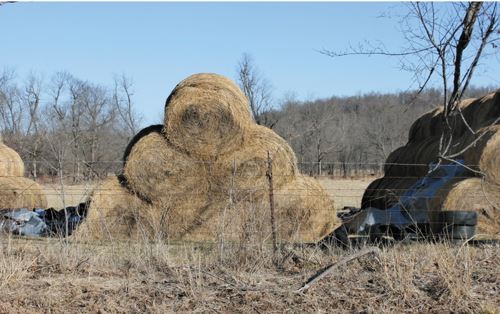Developing Round Hay Bale Yard Management That Minimizes Waste, Saves Money
MT. VERNON, MO.
It’s intriguing to observe big round bale yard management on farms in southwest Missouri. “Based on observation, it appears many farmers don’t take into consideration factors impacting the storability of big round bales,” said Eldon Cole, livestock specialist with University of Missouri Extension.
Cole says one factor for farmers as they move the hay from the hay field may be convenience. That refers to being convenient to store in the summer as well as easy to access for feeding time.
“Sometimes being convenient for the owner may create problems as pranksters may find it convenient for burning or thieves may steal some. Theft was more likely in 2012 when hay was scarce and valuable,” said Cole.
In addition, bale yards need to be on sloping ground that provides for good drainage. Not every convenient yard will have a slope to it. Soils in southwest Missouri are rockier which does add to the dryness of the yard.
“If those conditions don’t exist, place the bales on tires, railroad ties, a graveled area, up on some type of object or net wrap them. These items reduce the wicking effect that is so damaging to the lower portions of the bale,” said Cole.
The bale yard should have bales running in a north-south row. It is best to leave about three feet between rows of bales for air movement and drying purposes.
“The row of bales should be butted snugly end-to-end. Do not allow the sides of the bales to touch, again the reason is to reduce the soaking of rain or snow into the bale,” said Cole.
A number of bale yards are located near fence rows under shade trees. This is also a no-no according to Cole because of the shade and drips from the trees will prevent the bales from drying out sufficiently.
“Once in a while I see stacks of bales two, three or four high that are uncovered. This is a perfect design for waste. If the bale yard is small, I understand why you might think this a good idea, but it’s wasteful. Using a tarp or plastic on the top rows will minimize waste,” said Cole.

Big bale waste due to torn covering of bale pile.
Since the advent of the big round hay bales in the early 1970’s, a lot of hay has been lost due to outside storage. Cole says reducing hay crop losses with more thoughtful bale yard management is important and profitable in the long term.
“As you feed hay this winter, plan ahead to hay harvest time and develop a bale yard storage plan that minimizes your waste the next year,” said Cole.∆